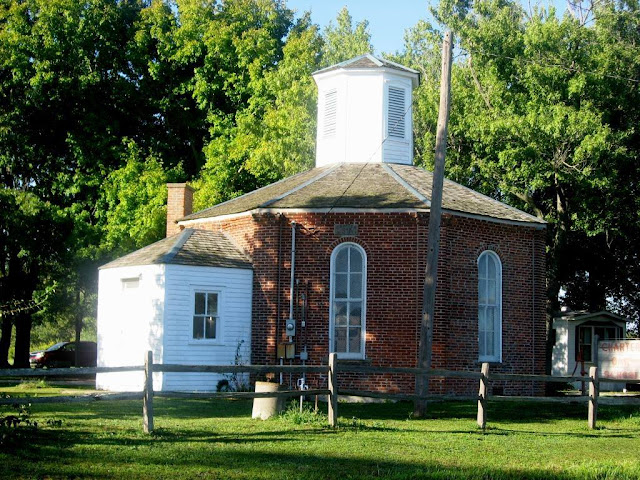 |
| The corner of Oak Street and Broadway, Centralia, Illinois. 1962 |
 |
| The corner of Oak Street and Broadway, Centralia, Illinois. circa 2014 |
Press, radio and television coverage was given the project throughout Southern Illinois and including metropolitan St. Louis as this city undertook to dedicate the steam engine as a memorial to the Age of Steam - commemorating the railroad industry which played such an important role in building this city.
Children climbed over the old engine, №. 2500, and argued over who was going to pull the cord. The locomotive glistened under a bright fall sun as it rested on its platform, signaling the end of a year's work for the large group of Centralians.

That move came as a surprise since the old engine was worth about $10,000 In scrap metal. It had been destined for the cutting torch when such steam engine enthusiasts as Jim Adams and retired engineer Ernie Dolan started the move to let up a tribute to railroading.
While others were observing Labor Day Weekend last September, volunteers began the laborious operation of moving the huge locomotive down Broadway.
Large crowds of curious spectators gathered and watched that first night when crews sweated to maneuver the engine around a makeshift bend to get if off the IC tracks and onto the street.
And many watched as men worked well into the night and sometimes into the early morning hours during the next week. Eight days later they pulled the engine onto the platform.
While they were moving it, one worker sustained an injured foot and another time a speeding motorist narrowly missed running down two police officers and crashing into a group of workers.
The workers, many of them railroaders, some retired, all donated their time. Local businesses donated materials and machinery to move the engine and build the platform for it at the park.
Soon after its arrival at Fairview, a fence was erected around №. 2500 and organized tours for Centralians and curious tourists alike were organized.
Members of the moving committee said several hundred visitors went through the engine on its first day at the park. Then they fixed up a registration book and in the past seven months, several thousand persons have signed their names after touring the engine.
Spotlights Illuminate No. 2500 nightly. The gate in the fence around it is closed then, but motorists often stop to observe the black engine.
Locomotive 2500 was the first engine ever to be issued a clearance card and running order down the main street of a city. Dispatcher F. W. Howell at the IC passenger station issued the order which gave the huge engine top priority down Broadway on September 4,1962.
It read: "Engine №. 2500 run extra from Oak Street to Fairview Park. Has right overall trains. Not to exceed a speed of 100 miles per hour." Lester Hanrahan, call-boy, called the following phantom crew: Engineer Ernie Dolan, Fireman J. W. Bailie, Conductor Eddie Copple, Brakeman Steve Opolony and Flagman Allen Ferguson.
Workmen said the moving of the steam engine was one of the most difficult railroad operations ever performed anywhere.
The engine's background is not able. It was built in 1921 by the Lima Locomotive Works in Ohio. Its original number was 2943. It has two small trucks in the lead, big driving wheels and two small trucks or trailers behind.
 |
| Engine Boiler and Controls of Locomotive №. 2500. |
Steam pressure was raised from 200 to 240 pounds. The engine is 96½ feet long. Its cylinders are 30 x 30. It weighs about 225 tons and has a total capacity of 24 tons of coal and 11,000 gallons of water.
During its 41 years of service, the engine traveled about a million miles. It was estimated that №. 2500 could produce 7000 horsepower, capable of pulling a 125-car train 25 miles an hour.
According to Dolan, a couple of high school boys, David Kracht and Lynn Redmond, originated the idea of a locomotive for a memorial. They gave the idea to Adams who later became chairman of the trust fund.
The fundraising was a long and tedious drive, members of the committee later said. The contributions ranged from 5¢ to $500.
The cooperation extended by Individuals and companies alike was noted by city officials, Chamber of Commerce officers, and others as a progressive step forward for the community.
Said Adams at the October 8 dedication ceremonies: “The wholehearted cooperation shown in this project demonstrates that we can cooperate in many other things.”
He continued: "The 2500 remains an example of magnificence from the colorful period in history in railroads known as the Age of Steam to which the 2500 stands as a memorial.
H. H. Koonce, superintendent of the St. Louis division of the IC Railroad, was the principal speaker. He told a hushed crowd; “Whistles screaming, headlights shining, her day is gone. She’ll blow her whistle no more,” he said.
Dedicated on October 6, 1962.
The Story of the 2500
From the Centralia (Illinois) Sentinel Newspaper, May 26, 1963.
Compiled by Neil Gale, Ph.D.













